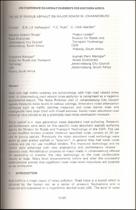JavaScript is disabled for your browser. Some features of this site may not work without it.
- ResearchSpace
- →
- Research Publications/Outputs
- →
- Conference Publications
- →
- View Item
| dc.contributor.author |
Horak, E

|
|
| dc.contributor.author |
Verhaeghe, Benoit MJA

|
|
| dc.contributor.author |
Rust, FC

|
|
| dc.contributor.author |
Van Heerden, C

|
|
| dc.date.accessioned | 2007-12-03T10:21:51Z | |
| dc.date.available | 2007-12-03T10:21:51Z | |
| dc.date.issued | 1994-10 | |
| dc.identifier.citation | Horak, E, et al. 1994. Use of porous asphalt on major roads in Johannesburg. 6th Conference on Asphalt Pavements for Southern Africa, Cape Town, South Africa, October, 1994, 65-81 | en |
| dc.identifier.uri | http://hdl.handle.net/10204/1734 | |
| dc.description.abstract | Roads with high traffic volumes are synonymous with high road related noise levels. In Johannesburg road related noise pollution is recognised as a negative environmental impact. The Noise Pollution Unit of Johannesburg City Council regularly measures noise levels in various settings. Innovative noise attenuation techniques such as traffic calming measures and noise barrier trials and investigations have been tried with mixed success. Lately noise absorbent road surfacings have proved to be a promising road noise attenuation measure. Porous asphalt is a new generation noise absorbent road surfacing. Research and development were done on this specific noise absorbent asphalt surfacing type by the Division for Roads and Transport Technology of the CSIR. The use of new modified binders enabled minimum specified voids content of 20 percent for porous asphalt. Previously the noise absorbent road surfacings were known as open graded asphalt or "popcorn". In general they had lower voids contents and did not use modified binders. The improved technology and its transfer were enhanced with new engineering and performance related laboratory tests. Rehabilitation projects on major roads in Johannesburg offered the opportunity to transfer this new technology to the road construction industry at large. Noise level measurements before and after the successful implementation proved that significant road noise level reductions are possible as was anticipated. | en |
| dc.language.iso | en | en |
| dc.subject | Porous asphalt | en |
| dc.subject | Noise levels | en |
| dc.subject | 6th Conference on asphalt pavements for Southern Africa | en |
| dc.subject | Johannesburg | en |
| dc.subject | Roads | en |
| dc.title | Use of porous asphalt on major roads in Johannesburg | en |
| dc.type | Conference Presentation | en |
| dc.identifier.apacitation | Horak, E., Verhaeghe, B. M., Rust, F., & Van Heerden, C. (1994). Use of porous asphalt on major roads in Johannesburg. http://hdl.handle.net/10204/1734 | en_ZA |
| dc.identifier.chicagocitation | Horak, E, Benoit MJA Verhaeghe, FC Rust, and C Van Heerden. "Use of porous asphalt on major roads in Johannesburg." (1994): http://hdl.handle.net/10204/1734 | en_ZA |
| dc.identifier.vancouvercitation | Horak E, Verhaeghe BM, Rust F, Van Heerden C, Use of porous asphalt on major roads in Johannesburg; 1994. http://hdl.handle.net/10204/1734 . | en_ZA |
| dc.identifier.ris | TY - Conference Presentation AU - Horak, E AU - Verhaeghe, Benoit MJA AU - Rust, FC AU - Van Heerden, C AB - Roads with high traffic volumes are synonymous with high road related noise levels. In Johannesburg road related noise pollution is recognised as a negative environmental impact. The Noise Pollution Unit of Johannesburg City Council regularly measures noise levels in various settings. Innovative noise attenuation techniques such as traffic calming measures and noise barrier trials and investigations have been tried with mixed success. Lately noise absorbent road surfacings have proved to be a promising road noise attenuation measure. Porous asphalt is a new generation noise absorbent road surfacing. Research and development were done on this specific noise absorbent asphalt surfacing type by the Division for Roads and Transport Technology of the CSIR. The use of new modified binders enabled minimum specified voids content of 20 percent for porous asphalt. Previously the noise absorbent road surfacings were known as open graded asphalt or "popcorn". In general they had lower voids contents and did not use modified binders. The improved technology and its transfer were enhanced with new engineering and performance related laboratory tests. Rehabilitation projects on major roads in Johannesburg offered the opportunity to transfer this new technology to the road construction industry at large. Noise level measurements before and after the successful implementation proved that significant road noise level reductions are possible as was anticipated. DA - 1994-10 DB - ResearchSpace DP - CSIR KW - Porous asphalt KW - Noise levels KW - 6th Conference on asphalt pavements for Southern Africa KW - Johannesburg KW - Roads LK - https://researchspace.csir.co.za PY - 1994 T1 - Use of porous asphalt on major roads in Johannesburg TI - Use of porous asphalt on major roads in Johannesburg UR - http://hdl.handle.net/10204/1734 ER - | en_ZA |






